Friday, September 30, 2016
The author of the review in the previous post, Dara Horn, supplies
below a midrash on "desmic," a term derived from the Greek desmé
( δέσμη: bundle, sheaf , or, in the mathematical sense, pencil —
French faisceau ), which is related to the term desmos , bond …

(The term "desmic," as noted earlier, is relevant to the structure of
Heidegger's Sternwürfel .)
The Horn midrash —

(The "medieval philosopher" here is not the remembered pre-Christian
Ben Sirah (Ecclesiasticus ) but the philosopher being read — Maimonides:
Guide for the Perplexed , 3:51.)
Here of course "that bond" may be interpreted as corresponding to the
Greek desmos above, thus also to the desmic structure of the
stellated octahedron, a sort of three-dimensional Star of David.
See "desmic" in this journal.
Comments Off on Desmic Midrash
From a review by Dara Horn of …
Critics, Monsters, Fanatics, & Other Literary Essays
by Cynthia Ozick
Houghton Mifflin Harcourt, 224 pp., $25
"… the credo that has emerged throughout her career:
against idolatry, yes, but also in favor of the particular,
context, rootedness, the profound archaeological wells
from which no writer can be removed without removing
his or her greatest powers.
For Ozick herself, that archaeological well is not only Anglo-
American literature, but the far deeper well of Judaism."
— "Cynthia Ozick: Or, Immortality,"
Jewish Review of Books , Fall 2016
See also Michener's The Source in this journal.
Comments Off on “Profound archaeological wells”
Thursday, September 29, 2016
Cassirer vs. Heidegger at Harvard —

A remembrance for Michaelmas —

A version of Heidegger’s “Sternwürfel ” —

From Log24 on the upload date for the above figure —

Comments Off on Articulation
When Philosophy Mattered
A review of …
Continental Divide : Heidegger, Cassirer, Davos
By Peter E. Gordon
(Harvard University Press, 426 pp., $39.95)
The reviewer: David Nirenberg in The New Republic .
The review, dated January 13, 2011, ran in the
February 3, 2011, issue of the magazine.
Comments Off on Reading for Michaelmas 2016
Wednesday, September 28, 2016
Comments Off on Quotes for Michaelmas (2015)

See also in this journal "desmic," a term related
to the structure of Heidegger's Sternwürfel .
Comments Off on Star Wars
From RIP, a post of Wednesday, March 16, 2016 —

See also earlier posts tagged Sermon Weekend.
From Balboa Press —
|
More than a pretty face designed to identify a product, a logo combines powerful elements super boosted with sophisticated branding techniques. Logos spark our purchasing choice and can affect our wellbeing.
Lovingly detailed, researched and honed to deliver a specific intention, a logo contains a unique dynamic that sidesteps our conscious mind. We might not know why we prefer one product over another but the logo, designed to connect the heart of the brand to our own hearts, plays a vital part in our decision to buy.
The power of symbols to sway us has been recognised throughout history. Found in caves and in Egyptian temples they are attributed with the strength to foretell and create the future, connect us with the divine and evoke emotions, from horror to ecstasy, at a glance. The new symbols we imbue with these awesome powers are our favourite brand logos.
• Discover the unconscious effect of these modern symbols that thrust our most successful global corporations into the limelight and our lives.
• Learn to make informed choices about brands.
• Find out how a logo reflects the state of the brand and holds it to account.
|
Comments Off on Logos
Tuesday, September 27, 2016
Or: Philosophy for Jews
From a New Yorker weblog post dated Dec. 6, 2012 —
"Happy Birthday, Noam Chomsky" by Gary Marcus—
"… two titans facing off, with Chomsky, as ever,
defining the contest"
"Chomsky sees himself, correctly, as continuing
a conversation that goes back to Plato, especially
the Meno dialogue, in which a slave boy is
revealed by Socrates to know truths about
geometry that he hadn’t realized he knew."
Socrates and the slave boy discussed a rather elementary "truth
about geometry" — A diamond inscribed in a square has area 2
(and side the square root of 2) if the square itself has area 4
(and side 2).

Consider that not-particularly-deep structure from the Meno dialogue
in the light of the following…


The following analysis of the Meno diagram from yesterday's
post "The Embedding" contradicts the Lévi-Strauss dictum on
the impossibility of going beyond a simple binary opposition.
(The Chinese word taiji denotes the fundamental concept in
Chinese philosophy that such a going-beyond is both useful
and possible.)
The matrix at left below represents the feminine yin principle
and the diamond at right represents the masculine yang .
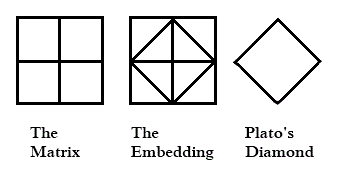
From a post of Sept. 22,
"Binary Opposition Illustrated" —

A symbol of the unity of yin and yang —

Related material:
A much more sophisticated approach to the "deep structure" of the
Meno diagram —

The larger cases —

Comments Off on Chomsky and Lévi-Strauss in China
Monday, September 26, 2016
Comments Off on Myspace China …
From this morning's 3:33 AM ET post —

Adapted from a post of Dec. 8, 2012, "Defining the Contest" —

From a post of Sept. 22,
"Binary Opposition Illustrated" —

From Sunday's news —

Comments Off on The Embedding
Eleanor Arroway and Palmer Joss in the "Occam's Razor"
scene from the 1997 film "Contact" —


Comments Off on Palmervision
Sunday, September 25, 2016
Stanford Encyclopedia of Philosophy
on the origins of Pragmatism:
"Pragmatism had been born in the discussions at
a ‘metaphysical club’ in Harvard around 1870
(see Menand…*). Peirce and James participated
in these discussions along with some other philosophers
and philosophically inclined lawyers. As we have
already noted, Peirce developed these ideas in his
publications from the 1870s."
|
From "How to Make Our Ideas Clear,"
by Charles Sanders Peirce in 1878 —
"The very first lesson that we have a right to demand that logic shall teach us is, how to make our ideas clear; and a most important one it is, depreciated only by minds who stand in need of it. To know what we think, to be masters of our own meaning, will make a solid foundation for great and weighty thought. It is most easily learned by those whose ideas are meagre and restricted; and far happier they than such as wallow helplessly in a rich mud of conceptions. A nation, it is true, may, in the course of generations, overcome the disadvantage of an excessive wealth of language and its natural concomitant, a vast, unfathomable deep of ideas. We may see it in history, slowly perfecting its literary forms, sloughing at length its metaphysics, and, by virtue of the untirable patience which is often a compensation, attaining great excellence in every branch of mental acquirement. The page of history is not yet unrolled which is to tell us whether such a people will or will not in the long-run prevail over one whose ideas (like the words of their language) are few, but which possesses a wonderful mastery over those which it has. For an individual, however, there can be no question that a few clear ideas are worth more than many confused ones. A young man would hardly be persuaded to sacrifice the greater part of his thoughts to save the rest; and the muddled head is the least apt to see the necessity of such a sacrifice. Him we can usually only commiserate, as a person with a congenital defect. Time will help him, but intellectual maturity with regard to clearness comes rather late, an unfortunate arrangement of Nature, inasmuch as clearness is of less use to a man settled in life, whose errors have in great measure had their effect, than it would be to one whose path lies before him. It is terrible to see how a single unclear idea, a single formula without meaning, lurking in a young man's head, will sometimes act like an obstruction of inert matter in an artery, hindering the nutrition of the brain, and condemning its victim to pine away in the fullness of his intellectual vigor and in the midst of intellectual plenty. Many a man has cherished for years as his hobby some vague shadow of an idea, too meaningless to be positively false; he has, nevertheless, passionately loved it, has made it his companion by day and by night, and has given to it his strength and his life, leaving all other occupations for its sake, and in short has lived with it and for it, until it has become, as it were, flesh of his flesh and bone of his bone; and then he has waked up some bright morning to find it gone, clean vanished away like the beautiful Melusina of the fable, and the essence of his life gone with it. I have myself known such a man; and who can tell how many histories of circle-squarers, metaphysicians, astrologers, and what not, may not be told in the old German story?"
|
Peirce himself may or may not have been entirely successful
in making his ideas clear. See Where Credit Is Due (Log24,
June 11, 2016) and the Wikipedia article Categories (Peirce).

* Menand, L., 2001. The Metaphysical Club : A Story of
Ideas in America , New York: Farrar, Straus and Giroux
Comments Off on Introduction to Pragmatism
Saturday, September 24, 2016
From Hermann Weyl's 1952 classic Symmetry —
"Galois' ideas, which for several decades remained
a book with seven seals but later exerted a more
and more profound influence upon the whole
development of mathematics, are contained in
a farewell letter written to a friend on the eve of
his death, which he met in a silly duel at the age of
twenty-one. This letter, if judged by the novelty and
profundity of ideas it contains, is perhaps the most
substantial piece of writing in the whole literature
of mankind."
Some Galois geometry —

See the previous post for more narrative.
Comments Off on The Seven Seals
For the director of "Interstellar" and "Inception" —
At the core of the 4x4x4 cube is …

Cover modified.
The Eightfold Cube
Comments Off on Core Structure
Friday, September 23, 2016

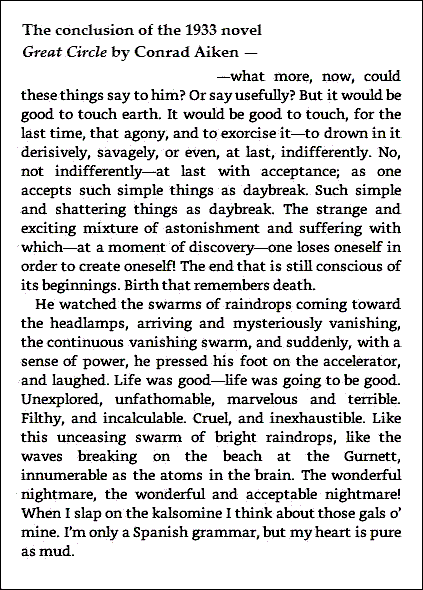
Great Circle is now available in a Kindle edition.
Comments Off on Screen Test
Last night, Thursday, Sept. 22, 2016, at Harvard's Sanders Theatre,
the annual Ig Nobel prizes were awarded.
This journal earlier that day —

Related material —

Comments Off on Annals of Scientism
Thursday, September 22, 2016
Comments Off on Near Zero

Click the above image for remarks on
"deep structure" and binary opposition.
See also the eightfold cube.
Comments Off on Binary Opposition Illustrated
"The Genesis of an Icon:
The Taiji Diagram's Early History"
By François Louis
Harvard Journal of Asiatic Studies
Vol. 63, No. 1 (June 2003), pp. 145-196
See also "arrowy, still strings" in this journal.

Comments Off on Equinox Note
Wednesday, September 21, 2016
The phrase "binary opposition" in the previous post suggests
a review of some binary-related concepts —
Boole at Cork —

From a post on St. Finbarr's Day 2015 —

From http://www.chosentwo.com/buffy/quotes/harvest.php —
|
Buffy: So, Giles! Got anything that can make this day any worse?
Giles: How about the end of the world?
Buffy: Knew I could count on you.
Giles: This is what we know. Some sixty years ago, a very old, very powerful vampire came to this shore, not just to feed.
Buffy: He came 'cause this town's a mystical who's it.
Giles: Yes. The Spanish who first settled here called it 'Boca del Infierno'. Roughly translated, 'Hellmouth'. It's a sort of, um, portal between this reality and the next. This vampire hopes to open it.
Buffy: Bring the demons back.
Xander: End of the world.
Willow: But he blew it! Or, I mean, there was an earthquake that swallowed half the town, and him, too.
Giles: You see, opening dimensional portals is a tricky business. Odds are he got himself stuck, rather like a, uh, cork in a bottle.
Xander: And this Harvest thing is to get him out.
|

Comments Off on Cork
Tuesday, September 20, 2016
Comments Off on Savage Logic
As the Key to All Mythologies
For the theorem of the title, see "Diamond Theorem" in this journal.
"These were heavy impressions to struggle against,
and brought that melancholy embitterment which
is the consequence of all excessive claim: even his
religious faith wavered with his wavering trust in his
own authorship, and the consolations of the Christian
hope in immortality seemed to lean on the immortality
of the still unwritten Key to all Mythologies."
— Middlemarch , by George Eliot, Ch. XXIX
Related material from Sunday's print New York Times —

Sunday's Log24 sermon —

See also the Lévi-Strauss "Key to all Mythologies" in this journal,
as well as the previous post.
Comments Off on The Diamond Theorem …
Monday, September 19, 2016
Comments Off on Post-It Aesthetics
The "points" and "lines" of finite geometry are abstract
entities satisfying only whatever incidence requirements
yield non-contradictory and interesting results. In finite
geometry, neither the points nor the lines are required to
lie within any Euclidean (or, for that matter, non-Euclidean)
space.
Models of finite geometries may, however, embed the
points and lines within non -finite geometries in order
to aid visualization.
For instance, the 15 points and 35 lines of PG(3,2) may
be represented by subsets of a 4×4 array of dots, or squares,
located in the Euclidean plane. These "lines" are usually finite
subsets of dots or squares and not* lines of the Euclidean plane.
Example — See "4×4" in this journal.
Some impose on configurations from finite geometry
the rather artificial requirement that both points and lines
must be representable as those of a Euclidean plane.
Example: A Cremona-Richmond pentagon —

A square version of these 15 "points" —

A 1905 square version of these 15 "points"
with digits instead of letters —

See Parametrizing the 4×4 Array
(Log24 post of Sept. 13, 2016).
Update of 8 AM ET Sunday, Sept. 25, 2016 —
For more illustrations, do a Google image search
on "the 2-subsets of a 6-set." (See one such search.)
* But in some models are subsets of the grid lines
that separate squares within an array.
Comments Off on Squaring the Pentagon
Sunday, September 18, 2016
Saturday, September 17, 2016
"Symmetry, yes, but logic?"
— Photo caption in the New York Times review of the 2008 Albee play
at Princeton titled "Me, Myself & I"


Above: Albee rests on Wittgenstein.
Comments Off on Symmetry and Logic
The late Edward Albee, as quoted today in The Telegraph :
“I tell my students, if you want to know something
about the structure of a play, listen to some Bach
preludes and fugues. I discovered classical music
when I was eight, nine, 10 years old, and I think
I learnt something about the nature of dramatic
structure from the nature of the music I was
listening to. I probably think of myself half the
time as a composer.”
See also Box as Bach's.
Comments Off on Composition
Comments Off on Interior/Exterior
Comments Off on A Box of Nothing
Friday, September 16, 2016
Comments Off on For Albee’s Walk of Fame

Related material —
See the story of a British man who reportedly had a doctorate in
physics and mathematics and became a witchcraft enthusiast.
He is said to have died at 85 on September 11, 2016.
As Wittgenstein noted, it is not always clear whether the pentagram
expresses a mathematical or an experiential proposition.
For some mathematical propositions related to the pentagram,
see (for instance) John Baez's slides for his 2008 Glasgow
lecture on the number 5.
For som experiential propositions, see Pentagram in this journal.
Comments Off on Wittgenstein’s Pentagram
Wittgenstein, 1939

Dolgachev and Keum, 2002

For some related material, see posts tagged Priority.
Comments Off on A Counting-Pattern
Thursday, September 15, 2016
"Every Story Has a Deadline"
— Cover of a novel, Graveland

Cover: Night at the Brooklyn Bridge
"Francesco Joseph Barbaro was born in Brooklyn
on Dec. 18, 1927. His father was an Italian immigrant
fisherman who became a master butcher. His mother
was from Sicily. They lived in what became known as
Carroll Gardens, then fell on hard times and moved
to Red Hook and then to Bensonhurst. . . . ."
— Obituary in yesterday's online New York Times
by Sam Roberts
Comments Off on Metaphysics in Brooklyn
Recommended reading —
"When Analogies Fail," by Alexander Stern,
a doctoral candidate in philosophy at Notre Dame, in
The Chronicle of Higher Education online September 11, 2016.
Related material —
That same Alexander Stern in this journal on April 17, 2016:

See also the eightfold cube in the previous post,
Metaphysics at Scientific American:

Comments Off on Metaphysics at Notre Dame
In 2011 Scientific American magazine ran
the following promotional piece for one of their articles —
"Why 5, 8 and 24 Are the Strangest Numbers
in the Universe," by Michael Moyer, "the editor
in charge of physics and space coverage."

This is notably bad metaphysics. Numbers are, of course,
not "in the universe" — the universe, that is, of physics.
A passage from G. H. Hardy's Mathematician's Apology
is relevant:
The contrast between pure and applied mathematics
stands out most clearly, perhaps, in geometry.
There is the science of pure geometry, in which there
are many geometries, projective geometry, Euclidean
geometry, non-Euclidean geometry, and so forth. Each
of these geometries is a model , a pattern of ideas, and
is to be judged by the interest and beauty of its particular
pattern. It is a map or picture , the joint product of many
hands, a partial and imperfect copy (yet exact so far as
it extends) of a section of mathematical reality. But the
point which is important to us now is this, that there is
one thing at any rate of which pure geometries are not
pictures, and that is the spatio-temporal reality of the
physical world. It is obvious, surely, that they cannot be,
since earthquakes and eclipses are not mathematical
concepts.
By an abuse of language such as Burkard Polster's
quoted in the previous post, numbers may be said to be
in the various "universes" of pure mathematics.
The Scientific American article above is dated May 4, 2011.
See also Thomas Mann on metaphysics in this journal
on that date.
Comments Off on Metaphysics at Scientific American
The smallest perfect number,* six, meets
"the smallest perfect universe,"** PG(3,2).


* For the definition of "perfect number," see any introductory
number-theory text that deals with the history of the subject.
** The phrase "smallest perfect universe" as a name for PG(3,2),
the projective 3-space over the 2-element Galois field GF(2),
was coined by math writer Burkard Polster. Cullinane's square
model of PG(3,2) differs from the earlier tetrahedral model
discussed by Polster.
Comments Off on The Smallest Perfect Number/Universe
Wednesday, September 14, 2016

* Spelling altered from the Stanford memorial page
to reflect the use of the term in this journal.
Comments Off on Bialystock* Story

See the three dead Solomons in a Log24 post of May 8, 2016.
See also two posts from July on the day Solomon Feferman died —


A sample of the work of Feferman —

See also a tribute to Feferman respectively .
Comments Off on The Fourth Solomon

For Mrs. Hyman, see the October Atlantic.
Comments Off on Arma Mulieremque Cano
Tuesday, September 13, 2016
The previous post discussed the parametrization of
the 4×4 array as a vector 4-space over the 2-element
Galois field GF(2).
The 4×4 array may also be parametrized by the symbol
0 along with the fifteen 2-subsets of a 6-set, as in Hudson's
1905 classic Kummer's Quartic Surface —
Hudson in 1905:

These two ways of parametrizing the 4×4 array — as a finite space
and as an array of 2-element sets — were related to one another
by Cullinane in 1986 in describing, in connection with the Curtis
"Miracle Octad Generator," what turned out to be 15 of Hudson's
1905 "Göpel tetrads":
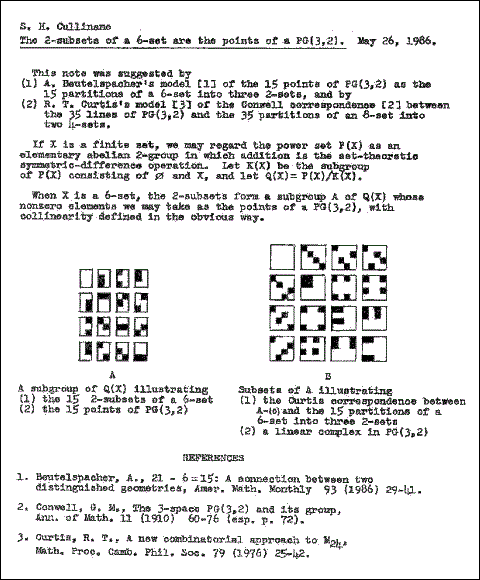
A recap by Cullinane in 2013:

Click images for further details.
Comments Off on Parametrizing the 4×4 Array
Monday, September 12, 2016
The previous post quoted Tom Wolfe on Chomsky's use of
the word "array."
An example of particular interest is the 4×4 array
(whether of dots or of unit squares) —
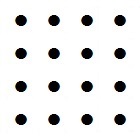
 .
.
Some context for the 4×4 array —
The following definition indicates that the 4×4 array, when
suitably coordinatized, underlies the Kummer lattice .

Further background on the Kummer lattice:
Alice Garbagnati and Alessandra Sarti,
"Kummer Surfaces and K3 surfaces
with $(Z/2Z)^4$ symplectic action."
To appear in Rocky Mountain J. Math. —

The above article is written from the viewpoint of traditional
algebraic geometry. For a less traditional view of the underlying
affine 4-space from finite geometry, see the website
Finite Geometry of the Square and Cube.
Some further context …
"To our knowledge, the relation of the Golay code
to the Kummer lattice … is a new observation."
— Anne Taormina and Katrin Wendland,
"The overarching finite symmetry group of
Kummer surfaces in the Mathieu group M24 "

As noted earlier, Taormina and Wendland seem not to be aware of
R. W. H. T. Hudson's use of the (uncoordinatized*) 4×4 array in his
1905 book Kummer's Quartic Surface. The array was coordinatized,
i.e. given a "vector space structure," by Cullinane eight years prior to
the cited remarks of Curtis.
* Update of Sept. 14: "Uncoordinatized," but parametrized by 0 and
the 15 two-subsets of a six-set. See the post of Sept. 13.
Comments Off on The Kummer Lattice
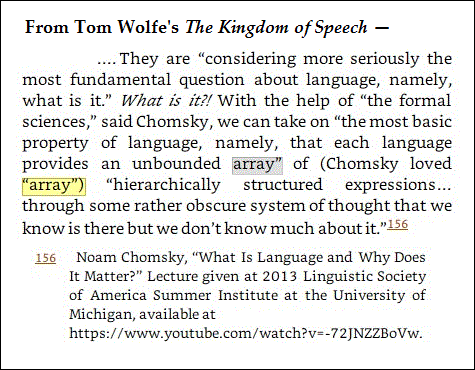
See also Array in this journal.
Comments Off on The Kingdom of Arrays
Sunday, September 11, 2016
(C. K. Williams and Crazy Eddie)
Todd Gitlin on C. K. Williams, dead on 9/20, 2015 —
"He is unabashed about soul-search, as here (“Brain,” from Wait ) :
'I was traversing the maze of my brain;
corridors, corners, strange, narrow caverns, dead ends.
Then all at once my being like this in my brain,
this sense of being my brain, became unbearable to me.
I began to wonder in dismay if the conclusion
I’d long ago come to that there can be nothing
that might reasonably be postulated as
the soul apart from body and mind
was entirely valid.' "
Times Square on Crazy Eddie, reportedly dead on Sept. 10, 2016 —
His prices …

Comments Off on In Memory of Two Poets
"Every Story Has a Deadline"
— Cover of a novel, Graveland

Comments Off on Night at the Brooklyn Bridge
Quivering Antennae

This journal on that date —

Comments Off on Annals of Journalism:
Comments Off on View Image Info
Saturday, September 10, 2016
Or: Elegy for Wiener Neustadt
That town outside Vienna was rather different in 1924,
the reported year of birth there of a woman whose obituary
appears in this evening's New York Times .
For the woman's later life, see the obituary.
See also a Log24 search for Times Square Church.
From the woman's reported date of death —

Comments Off on Church Search
The New Yorker , issue dated Feb. 9, 2015 —
"After trying magic mushrooms in Cuernavaca, in 1960,
Leary conceived the Harvard Psilocybin Project, to study
the therapeutic potential of hallucinogens. His involvement
with LSD came a few years later."
Related viewing —


Comments Off on Annals of Psychopharmacology
For the cocktail, see the following illustration, taken from
The New Yorker issue dated Sept. 12, 2016.
(The article accompanying the illustration is not recommended.)

* For more on the concept of "cocktail," search this journal for
Casablanca + Cocktail.
** For more on the concept of "damned," see Wikipedia on
the French group of writers and mathematicians that calls
itself Oulipo, and a recent novel by a member of that group.
Comments Off on Cocktail* of the Damned**
Friday, September 9, 2016
The New York Times interviews Alan Moore —
“A version of this article appears in print on September 11, 2016,
on page BR9 of the Sunday Book Review ….”
“What genres do you prefer? And which do you avoid?”
“To be honest, having worked in genre for so long, I’m happiest
when I’m outside it altogether, or perhaps more accurately,
when I can conjure multiple genres all at once, in accordance
with my theory (now available, I believe, as a greeting card and
fridge magnet) that human life as we experience it is a
simultaneous multiplicity of genres. I put it much more elegantly
on the magnet.”

Comments Off on Notation
( Sequel to the post of 12 AM Wednesday )
The following highlighted phrase was found, with a different spelling,
in The New Yorker issue dated Sept. 12, 2016.

The article in which the phrase was embedded is not recommended.
Neither is the book (which the foolhardy explorer may easily find)
from which the above snippet was taken.
* That of Fields of the Lord .
Comments Off on Welcome to the Jungle*
(Continued )
A 1984 master's thesis (PDF, 8+ MB) —
"Language, Linguistics, and Philosophy:
A Comparison of the Work of Roman Jakobson
and the Later Wittgenstein, with Some Attention
to the Philosophy of Charles Saunders Peirce,"
by Miles Spencer Kimball.
Two pages from that thesis —


Comments Off on Ein Kampf
Comments Off on There IS such a thing …
Thursday, September 8, 2016
The previous post deals with the theory, now becoming widely known,
that the musical "Grease" is really about Sandy's dying dream of heaven.
Another such dream in Oslo, described by the Vigeland Museum —
|
The Monolith
"The Monolith was carved from one single granite block, hence the name (mono: one, litho: stone). Whereas the melancholy theme in the fountain is the eternal life cycle, the column gives room to a totally different interpretation: Man's longing and yearning for the spiritual and divine. Is the column to be understood as man's resurrection? The people are drawn towards heaven, not only characterised by sadness and controlled despair, but also delight and hope, next to a feeling of togetherness, carefully holding one another tight in this strange sense of salvation."
|
I prefer a different monolith.
Comments Off on Hope of Heaven, Oslo Style
The notation "O" in the previous post suggests
a review of the new "Grease" theory in light of
a phrase from a May 2014 Oslo art exhibition —
"a desperate sense of imagined community."
Illustration (click for a video) —

"I'll have what she's having."
See as well Olivia Newton-John in this journal as the Muse of Dance.
Comments Off on Afternoon Delight
A Log24 noon post of June 29, 2016, The Mystery of O ,
links to the following passage —

This use of "O" is not a notation I recommend.
Comments Off on June 29 Meditation
Wednesday, September 7, 2016
Online Vogue today —

"For the first time, an exhibition at the Kunsthal Rotterdam—
'Peter Lindbergh: A Different Vision on Fashion Photography'—
will offer a robust survey of the photographer’s opus."
I find Lindbergh's early work as "Sultan" more interesting.

Comments Off on Strike a Pose
"May, / The months [sic ] of understanding" — Wallace Stevens
|
"If pure mathematics does spring from sub-conscious intuitions— already deep-structured as are grammatical patterns in the transformational-generative theory of language?— if the algebraic operation arises from wholly internalized pattern-weaving, how then can it, at so many points, mesh with, correspond to, the material forms of the world?"
— Steiner, George. Grammars of Creation
(Gifford Lectures, 1990). (Kindle Locations 2494-2496).
Open Road Media. Kindle Edition.
|
Good question.
See Bedtime Story (Sept. 1, 2016).
Comments Off on Grammar and Patterns
… For those taken aback by the tone of midnight's report
on the death of a 1960's counterculture figure.
See Didion's view of the counterculture in her classic
Slouching Towards Bethlehem .
A search in this journal for Didion + Nihilism yields …
|
From Wallace Stevens: A World of Transforming Shapes, by Alan D. Perlis, Bucknell University Press, 1976, p. 117:
… in 'The Pediment of Appearance,' a slight narrative poem in Transport to Summer …
A group of young men enter some woods 'Hunting for the great ornament, The pediment of appearance.' Though moving through the natural world, the young men seek the artificial, or pure form, believing that in discovering this pediment, this distillation of the real, they will also discover the 'savage transparence,' the rude source of human life. In Stevens's world, such a search is futile, since it is only through observing nature that one reaches beyond it to pure form. As if to demonstrate the degree to which the young men's search is misaligned, Stevens says of them that 'they go crying/The world is myself, life is myself,' believing that what surrounds them is immaterial. Such a proclamation is a cardinal violation of Stevens's principles of the imagination.
|

Comments Off on Related Reading…
Detail from the cover of the 1967 first issue of London's OZ magazine —

Other OZ news in Tuesday evening's online New York Times —

"Well, I tried to make it Sunday …" — America lyrics
Comments Off on Elegance
Tuesday, September 6, 2016


"Lévi-Strauss is an infatuated aesthetician."
— Boris Wiseman, Lévi-Strauss, Anthropology and Aesthetics ,
Cambridge University Press, 2007, p. 27
Last night's link from the Piper Laurie image leads to …

Related theoretical material — See Hudson + Tetrahedra.
Comments Off on Ethno-Aesthetics
Comments Off on Midnight Special
Monday, September 5, 2016
Comments Off on Sister Golden Hair
The previous post suggests a Log24 search for
Stevens + Sorbonne. This yields …
|
Michael Bryson in an essay on Stevens’s
“Notes Toward a Supreme Fiction,”
The Quest for the Fiction of the Absolute:
Canto nine considers the movement of the poem between the particular and the general, the immanent and the transcendent: “The poem goes from the poet’s gibberish to / The gibberish of the vulgate and back again. / Does it move to and fro or is it of both / At once?” The poet, the creator-figure, the shadowy god-figure, is elided, evading us, “as in a senseless element.” The poet seeks to find the transcendent in the immanent, the general in the particular, trying “by a peculiar speech to speak / The peculiar potency of the general.” In playing on the senses of “peculiar” as particular and strange or uncanny , these lines play on the mystical relation of one and many, of concrete and abstract.
|
"The poem goes from the poet’s gibberish to
The gibberish of the vulgate and back again.
Does it move to and fro or is it of both
At once?”
— Stevens, “Notes Toward a Supreme Fiction" (1942)
Par exemple , the previous post's title: "Space Case."
Comments Off on Stevens at the Sorbonne
The New York Times yesterday evening —
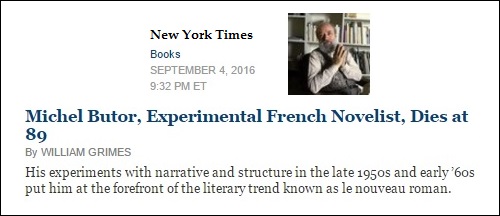
Butor reportedly died on August 24.
This journal on that date —

From Butor's obituary —
"He studied philosophy at the Sorbonne
under the phenomenologist
Gaston Bachelard, writing a thesis on
mathematics and the idea of necessity."
"In 2013 the Académie Française awarded
Mr. Butor its Grand Prix for his life’s work.
Explaining his philosophy in an interview
with the critic and television producer
Georges Charbonnier in 1965, Mr. Butor said,
'Every written word is a victory over death.' "
A search for Bachelard in this journal yields remarks
related to Bachelard's Poetics of Space and to the above
phrase by Wallace Stevens.
Comments Off on Space Case
The Lévi-Strauss “canonic formula” of myth in its original 1955 context,
described as that of permutation groups —

Related material in this journal —
Dueling Formulas and Symmetry.
Comments Off on Structural Study
Sunday, September 4, 2016
Quoted here at 10 PM Pacific Time on Friday night —
"If I should die before I wake,
All my bone and sinew take
Put me in the compost pile
To decompose me for a while . . . ."
— Poem by Lee Hays



Comments Off on Piled High and Deep
Saturday, September 3, 2016
For the Church of Synchronology, a correction of
a recent New York Times obituary by Daniel Lewis —
Actor Gene Wilder died early Monday, Aug. 29, not, as
earlier reported, late Sunday, Aug. 28.


See also the last Log24 post of Sunday night, Aug. 28 (Angles of Vision)
and the first post of Monday morning, Aug. 29, 2016 (Roll Credits).
* For some reading related to the title, see an Evil Genius page
by the late David Lavery mentioning Colin Wilson's novel
The Mind Parasites . Great entertainment for the tinfoil-hat crowd —
"More and more I feel like the narrator of Colin Wilson's
The Mind Parasites , a phenomenologist who, along with
a dedicated group of compatriots, struggles clandestinely
to overthrow alien invaders that have secretly
taken captive the 'deep structure' of the human mind."
Comments Off on Phenomenology*
CERN COURIER May 28, 1999:
In hot pursuit of CP violation
"CP was a consolation prize for physicists.
At least it seemed so until 1964."
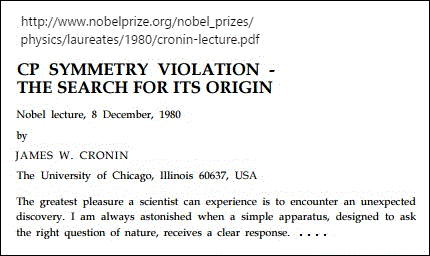

"James W. Cronin, who shared the Nobel Prize in physics
for discovering a startling breakdown in what was assumed
to be the immutable symmetry of physical law, thereby
helping to explain the behavior and evolution of the universe
as a whole, died Aug. 25 in St. Paul, Minn. He was 84.
Dr. Cronin’s death was announced by the University of Chicago,
where he was a professor emeritus of physics as well as of
astronomy and astrophysics. No cause was reported."
— Martin Weil in The Washington Post , August 28, 2016
Comments Off on CP is for Consolation Prize
Comments Off on Resplendent Triviality
In Dead Earnest
(Poem by Lee Hays, performed by Pete Seeger)
If I should die before I wake,
All my bone and sinew take
Put me in the compost pile
To decompose me for a while . . . .

For a different sort of decomposition, see the previous post.
Comments Off on Decomposition Song
Friday, September 2, 2016
"Now a little trivial heuresis is in order."
— The late Waclaw Szymanski on p. 279 of
"Decompositions of operator-valued functions
in Hilbert spaces" (Studia Mathematica 50.3
(1974): 265-280.)
See "A Talisman for Finkelstein," from midnight
on the reported date of Szymanski's death. That post
refers to "the correspondence in the previous post
between Figures A and B" … as does this post.
Comments Off on Heuresis
Some images from the posts of last July 13
(Harrison Ford's birthday) may serve as funeral
ornaments for the late Prof. David Lavery.


See as well posts on "Silent Snow" and "Starlight Like Intuition."
Comments Off on Raiders of the Lost Birthday
Thursday, September 1, 2016
The professor of the title is David Lavery,
who reportedly died Tuesday, August 30.
Lavery is the author of, among other things, the website
Evil Genius, which contains notes toward a fiction based
on a concept by Descartes.
In memoriam —

Comments Off on Requiem for a Professor
Continues .
The Guardian ‘s summary today of the new film “Arrival” —


“I have been agnostic about this kind of movie recently,
after the overwrought disappointments of Christopher
Nolan’s Interstellar and Jeff Nichols’s Midnight Special.
But Villeneuve’s Arrival is both heartfelt and very entertaining.”
— Peter Bradshaw in The Guardian today
As is Amy’s.
Comments Off on Where Entertainment Is God
For midnight retirees —

See also Leibniz medal in this journal.
Comments Off on Bedtime Story















































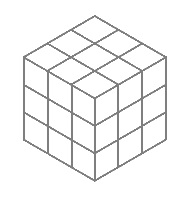

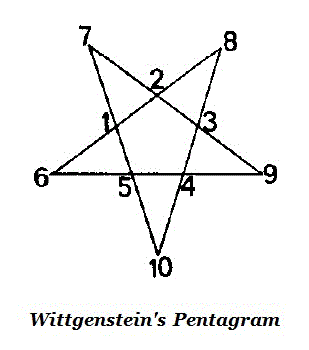
















 .
.
















































